ÓÄÊ 530.18 (ÓÄÊ 530.10(075.4))
S. N. Yalovenko
Black limit. Theory of relativity. New view
Introduction
Works on the given subjects were
published in the book «the relativity Theory a new sight» Õ: Publishing house "Fort" of 2004, and also
in the Bulletin of National technical university "ÕÏÈ" thematic release «New decisions in modern
technologies» Kharkov ¹43 for 2008 of p. 144
S.N.Jalovenko «the Black limit. ×àñòü1. The
relativity theory. A new sight», the book «the Black limit was published. The
relativity theory: a new sight» ÒÎÂ publishing
house "Fort" 2009ã. ISBN
978-966-8599-51-4
Extension of Lorentz transformations
Let us examine two inertial reference
systems Ê and Ê’ (Ê’ move relative to Ê with velocity v). We shall direct the coordinate
axes, how it is shown in figure 1.

To any event in
system Ê correspond values of
coordinates and time, equal to x, y, z, t, and in system Ê’ — x’, y’, z’, t’. It was considered in classical physics, that time in both systems flows the same way, that is t = t’. If at the moment t = t’ = 0 the origins of
coordinates of both systems coincided, then there are following correlations between the
coordinates of events in both systems:
x=x’+vt’=x’+vt
y=y’
z=z’ (1)
t=t’
q=q’ or ![]()
In equation (1) extension by q was introduced. Let us name this equation Galileo’s extended
transformation. Law of addition
of
velocities of classical mechanics:
![]()
![]()
![]() (2)
(2)
It is easy to see, that this law is in contradiction to the principle of constancy of the velocity of light. Really, if a light signal spreads in system Ê' with velocity ñ (è'õ = ñ), then according to (2) the
velocity of a signal will be found to equal ux=c+v
in system Ê, that is
it will surpass C. Hence
it follows, that Galileo’s transformations must be substituted with other
formulas. It is not difficult to find these formulas.
It follows from the uniformity of space, that the formulas of a transformation must not change,
when the origin of coordinates is carried over (that is, when õ is changed to õ + à and so on). Only
linear transformations can satisfy this condition. With the choice of
coordinate axes, indicated in fig.1, plane ó = 0 coincides with
plane ó' = 0, and
plane z = 0 — with plane z' = 0. Hence follows, that, for example, coordinates ó and ó' can be connected
only with correlation of such view:
![]() .
.
Because of full equality of systems Ê and Ê' the following correlation must be observed too:
![]()
with the same value of ![]() , as in the first case.
Multiplying both correlations, we shall receive
, as in the first case.
Multiplying both correlations, we shall receive ![]() , whence
, whence ![]() . Sign plus corresponds to equally directed axes ó and ó', sign minus — to axes, directed in opposite
directions. Directing the axes in equal directions; we shall
receive:
. Sign plus corresponds to equally directed axes ó and ó', sign minus — to axes, directed in opposite
directions. Directing the axes in equal directions; we shall
receive:
y=y’ (3)
Such speculations bring us to formula:
z=z’ (4)
Let us turn to finding transformations for õ and t. The origin of coordinates of system Ê has coordinate õ = 0 in system Ê, and õ' = —vt' in system Ê'. Therefore, when õ' + vt' is converted into zero, coordinate õ must be converted into zero too. For this linear transformation must have the following view:
![]() (5)
(5)
Analogously, the origin of coordinates of system Ê' has coordinate õ' = 0 in system Ê' and õ = vt in system Ê, whence it follows, that
![]() (6)
(6)
It follows from the full equality of systems Ê and
Ê', that the coefficient of proportionality in both cases must be the same (the different signs at v in these formulas is conditioned by the opposite directions of movement of the systems relative to each other — if
system Ê' is moving relative to Ê to the right, then
system Ê is
moving relative to Ê' to the
left).
Formula (5) allows to determine coordinate õ of an event in system K by the known coordinates õ' and
time t' of an
event in system Ê'. In order to find a formula for determination of time t of the
event in system Ê, we
shall exclude õ of
equations (5) and (6) and we shall solve the expression, which we have
received, relative to t. As a
result we shall receive:
 (7)
(7)
In order to find coefficient of proportionality ![]() , we shall use the
principle of constancy of velocity of light. Let us presume, that at the moment of time t = t'=
0 (in both systems time is counted from the moment, when their
origins of coordinates coincide) an impulse
is sent in the direction of axis õ. Namely
at this place of speculations we introduce extension, imagining light not as a
wave, but as particle, possessing an impulse and mass — virtual, but
subject to gravitational influence, like any material particle with mass
, we shall use the
principle of constancy of velocity of light. Let us presume, that at the moment of time t = t'=
0 (in both systems time is counted from the moment, when their
origins of coordinates coincide) an impulse
is sent in the direction of axis õ. Namely
at this place of speculations we introduce extension, imagining light not as a
wave, but as particle, possessing an impulse and mass — virtual, but
subject to gravitational influence, like any material particle with mass ![]() , where mass is found from equations of energy as
, where mass is found from equations of energy as
![]()
E=ħν
And the energy, which must be spent on overcoming of gravitation by this mass “m”, equals
![]()
That is light flow can be imagined (in
simplified form) as an exchange with balls with mass “m”.
So a light impulse produces a flash of light on a screen, which is in a point with coordinate õ=à. This event (the flash) is
described with coordinates õ = à, t = b in system
Ê è õ' =à', t’ =b' in system
Ê', à = ñb, à' = ñb', so the coordinates of an event in both systems can
be presented in the form:
x=cb, t=b è
x’=cb’, t’=b’
Having put these values into formulas (5) and (6), we
shall receive:
cb=![]() (cb’+vb’)=
(cb’+vb’)=![]() (c+v)b’
(8)
(c+v)b’
(8)
cb’=![]() (cb - vb)=
(cb - vb)=![]() (c – v)b .
(c – v)b .
Let us move from imagination of light as wave to imagination of light as a particle, possessing mass
“m”. Let us introduce an extension for equation (8), imagining light as impulse mv (or mc) and we shall
extend equation (8), rewriting it this way:
mcb=γ(cb’+vb’)m’=γ(c+v)b’m’ (8.1)
mcb’=γ(cb – vb)m’=γ(c – v)bm’ .
Having multiplied both equations, we shall come to
the correlation
![]()
Whence
 =
=![]() (9)
(9)
Where  is Lorentz coefficient,
is Lorentz coefficient,  is the coefficient of
interaction,
is the coefficient of
interaction, ![]() is energy, which a quantum of
light needs for overcoming of gravitational forces. If
is energy, which a quantum of
light needs for overcoming of gravitational forces. If ![]() , then
, then ![]() , and equation (9) acquires Lorentz
view, where
, and equation (9) acquires Lorentz
view, where  = L(V).
= L(V).
Substitution of this value into (5) and (7) will give final formulas for õ and t. Adding formulas (3) and (4) to
them, we shall receive the aggregate of equations;
 ,
,
y=y’, (10)
z=z’

![]()
By formulas (10) passage from the coordinates and time,
counted in system Ê', to the coordinates and time in
system Ê (briefly,
passage from system Ê' to
system Ê) is realized. If we solve equations (10) relative to the hatched values, we
shall receive formulas of transformation for passage from system Ê to system K':
 ,
,
y’=y,
(11)
z’=z,

![]()
As we should have expected, taking into consideration full equality
of systems Ê and Ê', formulas
(11) differ from formulas (10) only with the sign at v. Formulas (10) and (11) bear the name of extended Lorentz transformations with
consideration of the coefficient of interaction K(V). It is easy to see, that in the case ![]() (
(![]() ) transformations are converted into
Lorentz transformations, and at
) transformations are converted into
Lorentz transformations, and at ![]() Lorentz
transformations are converted into Galileo transformations (1). This way
Galileo transformations keep significance for velocities, small
in comparison to the light velocity. At v>c expressions (10) and (11) for õ, t, õ' and t'
become imaginary. It is in correspondence to the fact, that movement
with velocity, higher than the light velocity in vacuum, is impossible. We
cannot even use a system of coordinates, moving with velocity ñ, as with
v = ñ we
receive zero in the denominators of formulas for õ and t.
Lorentz
transformations are converted into Galileo transformations (1). This way
Galileo transformations keep significance for velocities, small
in comparison to the light velocity. At v>c expressions (10) and (11) for õ, t, õ' and t'
become imaginary. It is in correspondence to the fact, that movement
with velocity, higher than the light velocity in vacuum, is impossible. We
cannot even use a system of coordinates, moving with velocity ñ, as with
v = ñ we
receive zero in the denominators of formulas for õ and t.
Lorentz transformations are the base of the relativity theory. Farther all the computations are analogous with substitution
substitution of![]() to
to ![]() . Farther (in chapter “The theory of cold synthesis”) incompleteness of the theory and the
necessity of introduction of a third extension of Galileo transformations (or a third
negation …. +,0, ?).
. Farther (in chapter “The theory of cold synthesis”) incompleteness of the theory and the
necessity of introduction of a third extension of Galileo transformations (or a third
negation …. +,0, ?).
![]() .
.
Consequences from the extentsion of
Lorentz transformations.
A set of unusual, from the point of view of classical
mechanics, consequences.
Simultaneity of
events in different systems
of coordinates.
Let two events happen in system Ê in points with coordinates ![]() and õ2 at the point of time tl
= t2 = b. According
to formulas (11) the following coordinates will correspond to these events
in system Ê'
and õ2 at the point of time tl
= t2 = b. According
to formulas (11) the following coordinates will correspond to these events
in system Ê'
 ,
,

and moments of time
![]()
![]()
![]()
It can be seen from the written
formulas, that in the case, if
the events in system Ê happen in the same place of
space (![]() ), then they will coincide in the place of space (
), then they will coincide in the place of space (![]() ) and at the point of time (
) and at the point of time (![]() ) and in
system Ê' too. But if the events in system Ê are spatially disunited (
) and in
system Ê' too. But if the events in system Ê are spatially disunited (![]() ), then in system Ê' they will remain spatially disunited too (
), then in system Ê' they will remain spatially disunited too (![]() ), but they will not be simultaneous (
), but they will not be simultaneous (![]() ). Sign
of difference
). Sign
of difference ![]() is determined by the sign of
expression
is determined by the sign of
expression ![]() ; therefore in different
systems Ê' (at
different v) difference
; therefore in different
systems Ê' (at
different v) difference ![]() will be
different in value and may differ by the sign. It means, that in some systems event 1 will precede
event 2, in other systems, the other way round, event 2 will
precede event 1. Let us note, that the said information relates
only to events, between which causal connection is absent.
will be
different in value and may differ by the sign. It means, that in some systems event 1 will precede
event 2, in other systems, the other way round, event 2 will
precede event 1. Let us note, that the said information relates
only to events, between which causal connection is absent.
Length of bodies in
different systems.
Let us examine the rod, located
along axis õ and resting
relative to the coordinate system Ê' (fig. 2).

Its length in this system equals ![]() where
where ![]() x\ and õ'2 — coordinates of the ends of the rod, which do not change with time
x\ and õ'2 — coordinates of the ends of the rod, which do not change with time ![]() . Relative to system Ê the rod is
moving with velocity v. In order to determine its length in this system we
need to mark the coordinates of the ends of the rod
. Relative to system Ê the rod is
moving with velocity v. In order to determine its length in this system we
need to mark the coordinates of the ends of the rod![]() and õ2 at the same point of time
and õ2 at the same point of time ![]() = t2= b. Their difference
= t2= b. Their difference ![]() will give the length of the rod,
measured in system Ê. In
order to find correlation between
will give the length of the rod,
measured in system Ê. In
order to find correlation between ![]() and
and ![]() , we should take that formula of
the formulas of the extended Lorentz transformations, which
contains õ', õ and t, that is
the first of the formulas (11). According to this formula,
, we should take that formula of
the formulas of the extended Lorentz transformations, which
contains õ', õ and t, that is
the first of the formulas (11). According to this formula,
![]() ,
, ![]()
whence
![]()
or finally
 (12)
(12)
This way we have received an extended Lorentz transformation for the length of the rod/
If a rod of length ![]() rests relative to system Ê, then for
determination of its length in system Ê' we need to mark
the coordinates of ends
rests relative to system Ê, then for
determination of its length in system Ê' we need to mark
the coordinates of ends![]() and õ'2 at the same point of time
and õ'2 at the same point of time ![]() = t'2 = b. Difference
= t'2 = b. Difference ![]() will give the
length of the rod in system
will give the
length of the rod in system ![]() , relative to which it is moving with velocity v. Having
used the first of equations (10), we shall come to correlation (12)
again.
, relative to which it is moving with velocity v. Having
used the first of equations (10), we shall come to correlation (12)
again.
We shall remark, that in the direction of axes
ó and z the
dimensions of the rod are the same in all the coordinate systems.
The length of events in various
systems. Let an event, which lasts time ![]() , happens in a point, immobile
relative to system Ê'. Coordinate
, happens in a point, immobile
relative to system Ê'. Coordinate ![]() and moment of time
and moment of time ![]() , correspond to the
beginning of the event in this system,
and coordinate õ'2
= à and moment of time
, correspond to the
beginning of the event in this system,
and coordinate õ'2
= à and moment of time ![]() — to the end of the event.
Relative to system Ê the point, in which
the event is happening, is moving. According to
formulas (10) in system
— to the end of the event.
Relative to system Ê the point, in which
the event is happening, is moving. According to
formulas (10) in system ![]() the following
moments of time correspond to the beginning
and the end of the event:
the following
moments of time correspond to the beginning
and the end of the event:
![]() ,
, ![]()
whence
![]()
Having introduced
designations ![]() , we shall receive
, we shall receive
 (13)
(13)
This way we have received extended Lorentz transformation for time.
In this formula ![]() is the length of the event, measured by the clock of a system, moving with the same velocity, as the
body, in which the process is happening (the body is
resting in this system). Otherwise we can say, that
is the length of the event, measured by the clock of a system, moving with the same velocity, as the
body, in which the process is happening (the body is
resting in this system). Otherwise we can say, that ![]() was determined by the clock, moving together with the
body. Interval
was determined by the clock, moving together with the
body. Interval ![]() was measured by the clock of a system, relative
to which the body is moving with velocity v.
was measured by the clock of a system, relative
to which the body is moving with velocity v.
Time (as it will be shown lower) is directly connected
with mass, therefore, using invariant, we shall write extended Lorentz transformation for mass:
 (14)
(14)
Doppler effect.
Let us connect the beginning of coordinates of system Ê with the receiver of light, and the beginning of
coordinates of system Ê' with the source (fig. 3).

As usually, we shall direct the axes of coordinates õ and õ' along
the vector of velocity v, with which system Ê' (that is the
source) is moving relative to system Ê, (that is the
receiver). The equation of a flat light wave, emitted by the source in the
direction to the receiver, will have such view in system Ê':
![]() (15)
(15)
where ![]() is the frequency of the wave, fixed in the reference system,
connected with the source, that is the frequency, with which the
source is oscillating. In order not to limit the generalities, we presume, that
the initial phase
is the frequency of the wave, fixed in the reference system,
connected with the source, that is the frequency, with which the
source is oscillating. In order not to limit the generalities, we presume, that
the initial phase ![]() can be
different from zero. We have provided all the values with strokes, except ñ, which
is the same in all the reference systems.
can be
different from zero. We have provided all the values with strokes, except ñ, which
is the same in all the reference systems.
According to the principle of relativity the laws of
nature have the same view in all the inertial reference systems. Therefore in system Ê wave (15) is described with
equation:
![]() (16)
(16)
where ![]() is the frequency, fixed in reference
system Ê, that is
the frequency, perceived by the
receiver.
is the frequency, fixed in reference
system Ê, that is
the frequency, perceived by the
receiver.
Equation of wave in
system Ê can be received from equation (15), moving from õ' and ![]() to õ and t with extended Lorentz transformations. Having substituted in (15) õ' and t’ according
to (11), we shall receive:
to õ and t with extended Lorentz transformations. Having substituted in (15) õ' and t’ according
to (11), we shall receive:
![]()

 =
=
=  (17)
(17)
It is seen from equation (17), that at![]()
![]()
![]() , and frequency
, and frequency ![]() in system and
in system of source
in system and
in system of source ![]() are connected
as:
are connected
as:
 (18)
(18)
In the area of values ![]()
![]()
![]() , and frequency
, and frequency ![]() in system K’ and frequency
in system K’ and frequency ![]() in system K of the source of light are connected
as:
in system K of the source of light are connected
as:
 (18,1)
(18,1)
Other formulas are deduced in an analogous way.
Addition of speeds. We will consider
movement of a material point. In system ![]() point position is
defined during each moment of time t by co-ordinates õ,t, z. Expressions:
point position is
defined during each moment of time t by co-ordinates õ,t, z. Expressions:
![]()
![]()
![]()
Represent
projections to axes õ,t, z a vector of speed of a point concerning system Ê. In
system K’ point position is
characterized each moment of time in co-ordinates õ ’, t ', z '.
Projections to axes
õ ’, t ', z ' a vector
of speed of a point concerning system K' are defined by expressions:
![]()
![]()
![]()
From the formula
(10) follows, that
![]()
![]()
![]()

Let's divide first
three equalities into the fourth, we will receive formulas of transformation of
speeds at transition from one system of readout to another:

 (19)
(19)

In a case,
when ![]() that
that ![]() and the equation (19) gets ëîðåíöîâñêèé a kind, where
and the equation (19) gets ëîðåíöîâñêèé a kind, where  =L(V), when V<<C, parity
(19) pass in formulas of addition of speeds of classical mechanics.
=L(V), when V<<C, parity
(19) pass in formulas of addition of speeds of classical mechanics.
If the body moves
in parallel an axis ![]() , its speed
, its speed ![]() concerning system
concerning system ![]() , coincides from
, coincides from ![]() , and speed
, and speed ![]() concerning system
concerning system ![]() — with
— with ![]() . In this case the law
of addition of speeds looks like:
. In this case the law
of addition of speeds looks like:
 (20)
(20)
On fig. 4 the
behaviors of function is shown ![]() , on fig. 5 behaviors of function
, on fig. 5 behaviors of function
![]()



From drawings it is
visible, that at achievement ![]() speed
speed ![]() the sign on opposite falls and
changes, that means resistance to the further increase of speed in our
representation for the account of increase in the linear size of a body.
the sign on opposite falls and
changes, that means resistance to the further increase of speed in our
representation for the account of increase in the linear size of a body.
CHAPTER 1
Theory of relativity. New view.
Relativistic mechanics is
based on two postulates, which bear the names “the principle of relativity of
Einstein” and “the principle of constancy of the velocity of light”. In the
base of the theory of relativity was laid a proposition, according to which no
energy and no signal can propagate with a velocity, exceeding the velocity of
light in vacuum, and the velocity of light in vacuum is constant and it does
not depend on the direction of propagation.
In relativistic
mechanics the velocity of light is limited with Ñ — a constant instead of infinity and is absolutized, but at the same
time other infinite (or infinitely small) values are introduced. The notion of
infinity itself can be realized physically and must be understood only as
dialectic periodicity — it puts the completeness of the theory under doubt and
requires farther analysis of the processes, happening at velocities, comparable
to the velocity of light Ñ .
Let us examine
movement of protons and electrons at velocities, which are close to the
velocity of light.
It is known, that
the force of mutual attraction of two masses is ![]() . The energy, which must be spent on overcoming of gravitation:
. The energy, which must be spent on overcoming of gravitation: ![]() . Equalizing the escape velocity V to the velocity of light Ñ, we find
. Equalizing the escape velocity V to the velocity of light Ñ, we find ![]() it is the radius of a black
hole, the condition, at which light or another body can not leave the surface
of the body, and
it is the radius of a black
hole, the condition, at which light or another body can not leave the surface
of the body, and ![]() is the mass, which the object
must possess for the same conditions.
is the mass, which the object
must possess for the same conditions.
When any body is moving with
charge q, the body, having moved to a new place, must restore its field, that
is bring it into correspondence to its new position in space. It is equivalent
to propagation of an electromagnetic wave away from it, to which (to the wave)
energy E(L) corresponds. In order to remove such a wave from a new place, a
body with charge q must accomplish work against its gravitational forces. The
energy, spent on this is ![]() , where "m” is found from equation
, where "m” is found from equation ![]() ,
, ![]()
![]() . When the velocity of a body with charge “q" is
approaching the velocity of light, the energy, which must be spent on
restoration of the field, will increase in direct proportion to mass Ì and in inverse proportion to R — radius (volume).
Because a body is not always a sphere, in a general case the energy, spent on
overcoming of the gravitational field is in direct proportion to the density of
the body and in an ultimate case will be equal to the energy of a wave,
necessary for its restoration. Let us write the equation of
proportionality, which characterizes the degree of decrease of the energy of
the restoring wave, when the velocity of the body V is approaching the velocity of light Ñ.
. When the velocity of a body with charge “q" is
approaching the velocity of light, the energy, which must be spent on
restoration of the field, will increase in direct proportion to mass Ì and in inverse proportion to R — radius (volume).
Because a body is not always a sphere, in a general case the energy, spent on
overcoming of the gravitational field is in direct proportion to the density of
the body and in an ultimate case will be equal to the energy of a wave,
necessary for its restoration. Let us write the equation of
proportionality, which characterizes the degree of decrease of the energy of
the restoring wave, when the velocity of the body V is approaching the velocity of light Ñ.
![]() (1)
(1)
As it is seen from the
equation, the coefficient of proportionality or the coefficient of interaction
will counteract the increase of mass of the body, when V is approaching Ñ, that is now formula ![]() must be rewritten with
consideration of the counteraction as
must be rewritten with
consideration of the counteraction as ![]() , where
, where ![]()
![]() is the coefficient of proportionality,
received from the Lorentz transformations. With consideration of the presented
above we shall introduce a correction into the Lorentz transformations, and we
shall receive:
is the coefficient of proportionality,
received from the Lorentz transformations. With consideration of the presented
above we shall introduce a correction into the Lorentz transformations, and we
shall receive:
 ,
,
y=y’,
z=z’,
![]() ,
,
and also q(V) =
qK(V), where the charge is relative to the velocity (density) of the inertial
reference system. Expressions for the length and time are rewritten as: ![]() ;
; ![]() . When
. When ![]() , the coefficient of interaction
, the coefficient of interaction ![]() , and the expressions take the previous Lorentz view. It can be seen
from the coefficient of interaction, that G — the gravitational constant, — is
the characteristic
, and the expressions take the previous Lorentz view. It can be seen
from the coefficient of interaction, that G — the gravitational constant, — is
the characteristic ![]() of the density of vacuum. The
characteristics q(V) show, that when velocity V is approaching the velocity of light Ñ (when the relative density of
of the density of vacuum. The
characteristics q(V) show, that when velocity V is approaching the velocity of light Ñ (when the relative density of ![]() is approaching to the critical
density
is approaching to the critical
density ![]() — the density of a black hole),
the charge of the body will decrease, as if getting bold, and there will be
nothing to grab, in order to give additional energy to the body. Having done
approximate calculations, knowing, that
— the density of a black hole),
the charge of the body will decrease, as if getting bold, and there will be
nothing to grab, in order to give additional energy to the body. Having done
approximate calculations, knowing, that ![]() is the density of the core;
is the density of the core;![]() is the radius of the core;
is the radius of the core;![]() is the critical density of the matter, which collapsed, when
it was compressed to the sphere of the radius of Schwarzshild
is the critical density of the matter, which collapsed, when
it was compressed to the sphere of the radius of Schwarzshild ![]() , and having taken the derivative from M(V) = MK(V)L(V) and having
equated it to zero, we shall find maximum
, and having taken the derivative from M(V) = MK(V)L(V) and having
equated it to zero, we shall find maximum ![]() at
at ![]() , which is far from the possible sphere of the experiment. Divergence
from the theory of relativity appears in the spheres, inaccessible to the
sphere of the experiment, as they receive
, which is far from the possible sphere of the experiment. Divergence
from the theory of relativity appears in the spheres, inaccessible to the
sphere of the experiment, as they receive ![]() in modern accelerators, which differs
significantly from
in modern accelerators, which differs
significantly from ![]() , but which are possible at conduction of experiment in the spheres,
studied by astrophysics.
, but which are possible at conduction of experiment in the spheres,
studied by astrophysics.
When calculating
for a charged particle with mass Ì, coefficient K(V)
will equal:
 . (2)
. (2)
In this formula an assumption
was made, that (r) tends to zero in all the directions. It is not quite the
same for velocities, close to the velocity of light, but it gives an idea about
the tendencies of behaviour.
![]()
Let us find a more precise
value of K(V) with consideration of the fact, that the sphere at V, tending to
the velocity of light (Ñ), will be
approaching the shape of an ellipsoid, as it is shown in fig. 1. It can be
seen, that
![]()
where ![]() is a coefficient introduced for
simplification;
is a coefficient introduced for
simplification; ![]() is the density. Then the force, acting onto the body at the distance
is the density. Then the force, acting onto the body at the distance ![]() along the axis, is determined by
the formula:
along the axis, is determined by
the formula:
![]()
Where ![]() is the coefficient. Then the summed up force is:
is the coefficient. Then the summed up force is:
![]()
Along the ring ![]() , where
, where ![]() , and
, and
![]()
Then along the
cylinder at substitution ![]() the summed up force along the axis is:
the summed up force along the axis is:
![]() or
or 

Let us calculate the energy (Å), which must be spent on removal ![]() :
:

Here ![]() , where the density
, where the density  and
and ![]()
![]()
Then
 ,
,
Where ![]() . We shall rewrite the formula of the energy, which must be spent on
removal along the axis
. We shall rewrite the formula of the energy, which must be spent on
removal along the axis ![]() , as:
, as:

At  the formula can be written as:
the formula can be written as:
 .
.
Having put ![]() in, we receive:
in, we receive:
 .
.
Let us write the coefficient of proportionality for a spheroid:
 , (3)
, (3)
Where  , and
, and ![]() and
and ![]() ,
,
or  (4)
(4)
Let us build graphs for the mass of a charge, in order to view the processes more obviously (there will be
analogous, but inverse functions for length and time). For better visibility we shall conduct transformation
along the axis ![]() , and along the axis Õ we shall make the substitution
, and along the axis Õ we shall make the substitution ![]() , which will allow us to trace the function at
, which will allow us to trace the function at ![]() better:
better:

At ![]() function
function ![]() .
(5)
.
(5)
Let us calculate ![]() , where
, where ![]() . It can be seen, that coefficient
. It can be seen, that coefficient ![]() depends on the correlation
depends on the correlation ![]() . Now we calculate the correlation
. Now we calculate the correlation ![]() for an electron.
for an electron.
![]() (6)
(6)
For a proton the correlation ![]() is
is
![]() (7)
(7)
Where ![]() ;
; ![]() ;
; ![]() ;
; ![]() ;
; ![]() ;
; ![]() (although logically
(although logically ![]() must be a constant).
must be a constant).
In order to build the graph ![]() for a proton we shall make the substitution
for a proton we shall make the substitution ![]() ,
then the function is
,
then the function is

because at n>>1 the value ![]() , then
, then
![]() .
(8)
.
(8)
The function of mass ![]() with consideration
of the
coefficient of interaction by equation (2) will look like this for a
proton:
with consideration
of the
coefficient of interaction by equation (2) will look like this for a
proton:
 (9)
(9)


![]() (10)
(10)
In fig. 2 are built classical graphs of the function ![]() , in fig. 3 — the same graph in logarithmic scale,
, in fig. 3 — the same graph in logarithmic scale,
![]()

in fig. 4-7 are the same graphs in logarithmic
scale with consideration of the interaction function K(V).




In fig. 8 is shown the graph of dependence of charge q on the velocity for the classical
model,
where charge q = const and it does not depend on the velocity of a body,

![]()

In fig. 9, 10 — the graphs of dependence of charge q on the velocity with
consideration of the function of interaction K(V).
![]()
![]()

In fig. 11 is shown the graph of dependence for length ![]() on the velocity (V) with consideration of the function of interaction
(2) in logarithmic scale, in fig. 12,13 — generalizing graphs for mass (time) and length.
on the velocity (V) with consideration of the function of interaction
(2) in logarithmic scale, in fig. 12,13 — generalizing graphs for mass (time) and length.
It is seen from graphs in fig. 5, that negative mass ![]() (the stroked area) has formed, which corresponds to
Thomson radiation in vacuum
(the stroked area) has formed, which corresponds to
Thomson radiation in vacuum ![]() . For a
medium the velocity of light in vacuum must be
substituted with
. For a
medium the velocity of light in vacuum must be
substituted with ![]() — the velocity of light in the medium and all
the calculations in formulas (1)–(10) must be done for
— the velocity of light in the medium and all
the calculations in formulas (1)–(10) must be done for ![]() . We shall receive Thomson radiation for the medium, the frequency of
which equals:
. We shall receive Thomson radiation for the medium, the frequency of
which equals:
![]()
We generalize the
received
formulas:



![]()
![]()
It can be seen from the formulas, that, having limited the velocity of light, we have received infinite mass. Having
introduced a limit for mass, having limited mass with a black hole, that is no body can overcome
the mass
of a black hole, which it is tending to: ![]() .
.
As a result we have received new infinite values for length ![]() and the relativity of the
charge of a body
and the relativity of the
charge of a body ![]() .
.
Let us put the
question to ourselves: are there limitations for length? Probably, yeah, and these limitations are
connected with the dimensions of our Universe, that is ![]() is tending not to infinity, but
at ( R ) — the radius of the Universe,
at least beginning from the moment of the big explosion. In this sense length and time are manifestations
of single entity. Therefore, at the record
is tending not to infinity, but
at ( R ) — the radius of the Universe,
at least beginning from the moment of the big explosion. In this sense length and time are manifestations
of single entity. Therefore, at the record
![]()
The third, lacking, expression, is under question and its influence on the ends of the
graphs in fig. 10, 12 and 13 will be significant. Let us examine this influence
in the following chapters. Presumably, this is a function of long–range action and it can be
written as:
 .
.
And the influence
of the function of long–range action D(V) on the graphs in fig. 12 and fig. 13 are shown in
fig. 14–22 in generalized view:









Where L(V) is a Lorentz transformation, K(V) is the coefficient of
interaction, D(V) is the coefficient of long–range action.
CHAPTER 2
Experiments in a bathroom
WHIRLPOOLS
Let us conduct experiments on water as the most
close and accessible analogue of ether. Let us create a
whirlpool. But how can we make the whirlpool move (if the mountain is not coming
to Muhammad, then Muhammad is coming to the mountain)? We shall leave the
whirlpool immobile and make the water mobile, and watch, what is happening
(fig. 1):
![]()
We can notice, that radius R changes depending on velocity V proportionally to  , where
, where ![]() is the maximal velocity, at which the whirlpool
breaks away. It can be seen, that the angle of inclination behaves as inertial mass and puts up resistance too,
which is proportional to
is the maximal velocity, at which the whirlpool
breaks away. It can be seen, that the angle of inclination behaves as inertial mass and puts up resistance too,
which is proportional to ![]()
 , and which is well described with this formula at a certain sector, but
at the approximation
, and which is well described with this formula at a certain sector, but
at the approximation ![]() this correlation is broken. Why? The lines of the whirlpool spread too, condensing in front and spreading from the rear (fig. 2), changing their angle of inclination because of the addition of the velocities
this correlation is broken. Why? The lines of the whirlpool spread too, condensing in front and spreading from the rear (fig. 2), changing their angle of inclination because of the addition of the velocities ![]() as vectors, which leads to
increase of the resistance of the medium and transgresses the dependence
as vectors, which leads to
increase of the resistance of the medium and transgresses the dependence![]()
 . The closer
. The closer ![]() , the more the steepness is increasing and is
described with a higher exponential function.
, the more the steepness is increasing and is
described with a higher exponential function.

We shall denote the counteracting function additionally by means of the viscosity function ![]()

![]() , which will add the necessary
power and compensate the divergence at
, which will add the necessary
power and compensate the divergence at ![]() .
.
We can conduct an experiment on annihilation of whirlpools, rotating in opposite directions, noting, that a whirlpool has a rotation momentum, and that
certain conditions are necessary for sustention of stable whirlpools. Other whirlpools fall apart, and the speed of their collapse is in inverse proportion to ![]() — deviation of the rotation
frequency form the resonance frequency, and it is in direct proportion to the
prerotation force
— deviation of the rotation
frequency form the resonance frequency, and it is in direct proportion to the
prerotation force ![]() . The stronger the whirlpool has been prerotated, the longer time
. The stronger the whirlpool has been prerotated, the longer time ![]() it lives, but the farther is its frequency from the resonance frequency (at the same prerotation force), the less time the whirlpool lives (much in common with
the life of elementary particles, if we introduce certain rules). Then the total time of life of the whirlpool
it lives, but the farther is its frequency from the resonance frequency (at the same prerotation force), the less time the whirlpool lives (much in common with
the life of elementary particles, if we introduce certain rules). Then the total time of life of the whirlpool ![]() is proportional to
is proportional to ![]() , where Ê is the coefficient of proportionality (for whirlpools, which are flowing
out).
, where Ê is the coefficient of proportionality (for whirlpools, which are flowing
out).
It is interesting
to note, that, when the density of water is changing, an analogue of
gravitation is created between objects. For example, two ships, going in
opposite meeting directions, are attracted one to the other. But how can we create a stably sustained density? Perhaps, only by means of whirlpools. Experiments in superfluid media would present some interest because of absence of friction in them,
unlike in water, but there is no possibility to conduct them. Although the main
tendencies, and conformities to natural laws,
can be watched on water too, presence of friction can distort the picture. Also
we take away beforehand and take into consideration the Coriolis effect.
Farther we
introduce the notion of krypton. Krypton is a discrete element of space, not ether. Ether is something going through us. If
compared to ether, we are that very ether. Krypton is not a wave and it
is not a particle, it is a
discrete element of space. If we compare it to the water model, it is an analogue
of a discrete molecule of water. We shall project the water model onto the
model of space, conducting experiments in one model (water), and we
shall project them onto the space (krypton) model, presuming their
similarity (approximate, of course).
In fact, noting, that change of the density of water causes the effect of attraction, we shall project
it onto the krypton model of space, presuming, that gravitation is consequence of change
of the density of kryptons ![]() in space (fig. 3).
in space (fig. 3).


Then we note, that with the change ![]() of the density of water the sound propagation velocity
of the density of water the sound propagation velocity ![]() changes too, where
changes too, where ![]() is the density function,
is the density function, ![]() of air, and for water
of air, and for water ![]() , then
, then ![]() . That is, when the density of water is decreasing, the sound velocity in water will decrease and
in the limit tend to zero
. That is, when the density of water is decreasing, the sound velocity in water will decrease and
in the limit tend to zero ![]() at
at ![]() .
.
Then, presuming, that atoms and other particles are whirlpools (the principle of superposition–composition
is fulfilled for water). With consideration of the principle of superposition, having made a
projection onto the space krypton model near big masses, we shall come to the
conclusion, that the velocity of light must decrease ![]() , that is
, that is ![]() is the function of density of a
krypton.
is the function of density of a
krypton.
Experiment 1. In fig. 4 are shown two similar tracks , which light passes, but the first track passes near a big object of mass Ì, which curves the track of light.

The question arises: ![]() ?
(1)
?
(1)
or
![]() ?
(2)
?
(2)
In the first case the velocity of light is constant, and in the second light has passed some section of the
track,
with the velocity ![]() in vacuum, and therefore the velocity of light was changing
because of changes of density
in vacuum, and therefore the velocity of light was changing
because of changes of density ![]() of the krypton model:
of the krypton model:
![]() (3)
(3)
![]()
Experiment 2 (fig. 5). The task is the same — an experiment on curving of the
track of light near sun. If inequality (2) is received, then light has passed a section of track with![]() . And then
. And then
![]() .
(4)
.
(4)
Let us examine the whirlpool in
movement from aside (fig. 6).
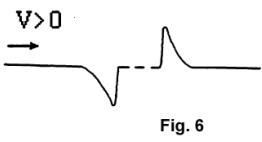
We can to notice the stroke billow in front and the reverse billow behind, which corresponds
to the increase of density in front and the decrease of density behind. We can
presume, that as much water has
increased in front, as much has decreased behind. In fig. 7 an analogous vacuum krypton
model of space is
shown.

Let us examine these two whirlpools in
movement, we shall send a signal between them.
![]()
In fig. 8 the whirlpools do not move and the
time of passage of the signal is
![]() (5)
(5)
![]()
In fig. 9 are shown moving whirlpools.
![]()
In fig. 10 is shown a simplified model, in which the exponents are substituted with direct lines (in this way it is
easier to understand the essence). If we send a signal from one whirlpool to the other from
point ![]() to point
to point ![]() , the track increases and the time
, the track increases and the time
![]() (6)
(6)
![]() (7)
(7)
At this the time of passage will not change. The transition from system in fig. 8 to the system in fig. 10 is an analogue of Lorentz transformations.
For the krypton model (fig. 11), if we send a signal
from one whirlpool to the other, then it will pass
the 1–st section with velocity, higher than the velocity of light ![]() ;
;
the 2–nd section with the velocity of light ![]() ;
;
It will pass the 3–rd section with velocity, lower than the velocity of light ![]() .
.
The total time will be the same, as for the immobile krypton whirlpool (5):
![]() ,
,

![]() .
.
Therefore nothing will change in the whirlpool, as light passes one section of the track with a velocity, bigger than the velocity of light because of the increasing density of a krypton, and the second
section of the track — with a velocity, lower than the velocity of light, as the density of a krypton decreases. It is
an analogue of the Michelson–Morley
experiment with moving mirrors.
We can notice, that when the whirlpool, moving in water, is stopped (fig.
12, 13)
![]()
radiation of energy by the wave, equal to — the stroked area, happens (It is not clear, what happens to the
rear part. Because of the quick stop with a slat the whirlpool is destroyed). The same is for
the krypton model fig. 13, where
.
The pleats fig. 14 appear on the crest at big velocities V>>0 in the whirlpool:
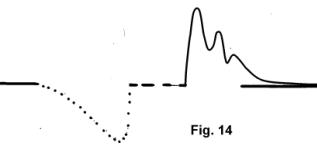

These pleats resemble displacement of a table–cloth. It is not excluded, that when a star is compresses ![]() to a black hole, the gravitational field will transform from the proportional
to a black hole, the gravitational field will transform from the proportional ![]() will be near the object:
will be near the object:
![]() .
.
The gravitational field will compress into pleats with a definite period Ò — a gravitational period. And gravitation is also a wave, spread within the
limit, as it is shown in fig. 15.
The same way the gravitational and electromagnetic fields will differ from the classical fields, as it is shown in fig. 15.1,3,5, and they will twist for the rotating (for a rotating
negative charge or ýëåêòðîíà fig. 15.2, fig. 15.8. for a
rotating positive charge or a proton fig. 15.4, fig. 15.8. for a gravitational
rotating body fig. 15.6) bodies, as it
is shown in fig. 15.2, 4, 6 because during rotation, as it is shown in fig. 15.7, forces ![]() by reason of Doppler additions
and a delay.
by reason of Doppler additions
and a delay.
![]()
![]()
![]()






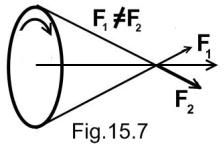
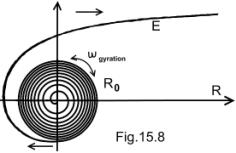
Where ![]() is the function of frequency and mass; F is force
without rotation. But because of the big value of the velocity of light and often small Doppler forces on a small section they can be considered
approximately linear functions — fig. 15.1, 3, 5. One can say, that nature does not like
emptiness, linearity (uniformity) and
purity.
is the function of frequency and mass; F is force
without rotation. But because of the big value of the velocity of light and often small Doppler forces on a small section they can be considered
approximately linear functions — fig. 15.1, 3, 5. One can say, that nature does not like
emptiness, linearity (uniformity) and
purity.
Now we describe the types of whirlpools, for
convenience we shall picture them from aside:
![]()
In fig. 16 is the view of a whirlpool from
aside, in fig. 17 — its simplified model. As it can be seen from the figures, squares ![]() and
and ![]() are the same, and presumably the energies of the whirlpools are
equal (
are the same, and presumably the energies of the whirlpools are
equal (![]() ), but the life time is different:
), but the life time is different: ![]() .
.
In case of opposite flows whirlpools with opposite signs are
observed, but with very short life times ![]() (fig. 18 and fig. 19).
(fig. 18 and fig. 19).
![]()
Analogous models must be observed in their krypton analogues with right–side and left–side twists (clockwise and
counter–clockwise).
As i described
earlier,
when
the speed of the whirlpool increases (fig. 20 and fig. 21),
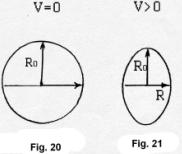
R — lengthwise radius decreases and is described in the first
approximation as:

The volume of the whirlpool decreases
proportionally:

Analogous changes are true for the krypton model too, with
substitution of ![]() for
for ![]() . And as the volume decreases,
. And as the volume decreases, ![]() — density inside the whirlpool changes
proportionally too, and therefore the speed inside the whirlpool
— density inside the whirlpool changes
proportionally too, and therefore the speed inside the whirlpool ![]() will change for the krypton model. So, time t inside a moving and an immobile whirlpool will be
different because of different density inside them:
will change for the krypton model. So, time t inside a moving and an immobile whirlpool will be
different because of different density inside them:

![]()
Time is also discrete ![]() , and it is a function of density of a krypton, and it can be
viewed as interaction of kryptons.
, and it is a function of density of a krypton, and it can be
viewed as interaction of kryptons.
Counteraction of
the medium — analogue of increase of inertial mass, as it was described above,
equals:

We must observe the same for their whirlpool krypton analogues too.
In this case we examined a krypton model with the minus
sign, where
![]()
Here, when a whirlpool is created, the density and the velocity of light decrease for whirlpools with the minus sign. But
we can conduct all the speculations, set forth above, for whirlpools with the plus sign too,
where
![]()
When a
whirlpool is created, the density
increases, and the velocity of light decreases for a whirlpool with the plus sign, which is difficult to create experimentally. The plus and minus models are almost symmetrical, but in one case (the minus model) ρ(v)→0, and in
the other case (the plus model) ρ(v)→∞.
The whirlpool krypton model does not contradict physical experiments. It just interprets, examines them from another point of
view.
However strange it is, the matter, which we observe, is rather absence
of matter from the point of view of the krypton model.
CHAPTER 3
A plane, which creates
volume. Is vacuum emptiness or an ocean?
Let us put the question: why do all the values
in the main formulas, which we know, decrease proportionally to ![]() , although according to the logic, increasing in volume, they must
decrease proportionally to
, although according to the logic, increasing in volume, they must
decrease proportionally to ![]() the cube?
the cube?
Let us combine the whirlpool and krypton theories with light. Instead of two opposite water flows, two light flows meet, which can pass through each other, like we often see, waves pass on water. But under certain conditions their tenseness vectors ![]() can create a whirlpool, which will catch two light flows, transforming the forward energy into rotational energy
and creating a spiral.
can create a whirlpool, which will catch two light flows, transforming the forward energy into rotational energy
and creating a spiral.
![]()
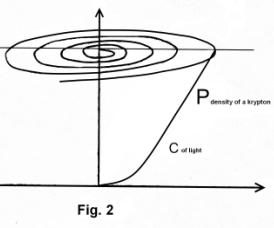
But we know, that light moves with velocity Ñ, and as light is coming to the centre of the spiral (fig. 1, 2) its (light) speed is tending to
zero ![]() , when
, when ![]() . In order to satisfy this requirement, the density of the whirlpool
. In order to satisfy this requirement, the density of the whirlpool ![]() , when
, when ![]() , must tend to zero
, must tend to zero ![]() and the velocity of light, when
and the velocity of light, when ![]() , will tend to zero too
, will tend to zero too ![]() . Then the system will be stable and non–contradictory. Changing of the density of the whirlpool towards the centre leads to changing of the velocity of light, creating
conditions for a stable system.
. Then the system will be stable and non–contradictory. Changing of the density of the whirlpool towards the centre leads to changing of the velocity of light, creating
conditions for a stable system.
![]()
![]()
But a
light wave consists of alternating
(+ - + - + - + - +) plusses and minuses of the intensity of the electric
(magnetic) fields. What must their location in the spiral be like and what
meaning has packing for the stability of a system (![]() of life) (fig. 3)?
of life) (fig. 3)?
It is reasonable to suppose, that if all the (–) minuses are located
opposite plusses (+), it will add extra stability to the system. If a part of them does not coincide, then the bigger is
this part, the shorter is the time of life of the system ![]() , which will lead
to a collapse. If we build a graph of changing of the density of time for the quadrature whirlpool (
, which will lead
to a collapse. If we build a graph of changing of the density of time for the quadrature whirlpool (![]() ) and juxtapose it with the graph of
changing
of the frequency of the
packing fig. 3.1, we see, that two stable states exist (at the crossing of the
graphs) with consideration of the discreteness of time and frequency, which
correspond to the masses of an electron (positron) and a proton (antiproton).
) and juxtapose it with the graph of
changing
of the frequency of the
packing fig. 3.1, we see, that two stable states exist (at the crossing of the
graphs) with consideration of the discreteness of time and frequency, which
correspond to the masses of an electron (positron) and a proton (antiproton).
We note, that light is characterized with flat functions Å and Í. Therefore the received system will be characterized with these
flat functions, that is all the
dependences will be proportional to ![]() or
or ![]() , and the system will resemble a rolled sheet. If we make a section in
the middle, the view will be like in fig. 4, graph 1. Where the graph is
represented with the function:
, and the system will resemble a rolled sheet. If we make a section in
the middle, the view will be like in fig. 4, graph 1. Where the graph is
represented with the function:
![]() (1)
(1)
Here ![]() is the function of proportionality, with
is the function of proportionality, with![]() , where
, where ![]() is the average value, which characterizes the density of krypton (vacuum),
is the average value, which characterizes the density of krypton (vacuum), ![]() is the frequency of a quantum of light,
is the frequency of a quantum of light,![]()
![]() is the amplitude of the wavetrain,
is the amplitude of the wavetrain, ![]() is the function of time,
changing because of changing of the density of krypton, when approaching the centre of the whirlpool. For a
whirlpool of the view
is the function of time,
changing because of changing of the density of krypton, when approaching the centre of the whirlpool. For a
whirlpool of the view ![]() at N = 2 equation (1) will equal:
at N = 2 equation (1) will equal: ![]() .
.
![]()
![]()
Because a whirlpool is
in inverse proportion to a square only at a first approximation, by shape it is closer to a turned over bell (fig. 4.1). The first
sinusoids will be stretched — the graph in
fig. 4.
Let us examine a whirlpool, created
by half of the length of a wave ![]() , fig. 5.
, fig. 5.
![]()
Having laid the whirlpool onto half of the length of the wave, we see, that it will twist the ends of the sinusoid till
infinity, the ends will decrease proportionally to ![]() . With consideration of the said facts, we must change the ends in fig.
4 and in the end we shall receive the view in fig. 6 (supposedly for an
electron) and in fig. 6.1 (for a proton). The ends are twisted and they decrease
. With consideration of the said facts, we must change the ends in fig.
4 and in the end we shall receive the view in fig. 6 (supposedly for an
electron) and in fig. 6.1 (for a proton). The ends are twisted and they decrease
![]() under the influence of the whirlpool and the flat function.
under the influence of the whirlpool and the flat function.
When the notion of a krypton as an element of discrete space was introduced, nothing was said about
its properties except, that it is an analogue of a superconducting liquid. Let us presume, that a krypton, like discrete molecules, performs chaotic movements in all directions and possesses infinite energy in a sum (which, most likely, lies in the
basis of creation of our Universe), which is close to the model of water, the
molecules of which perform disorderly movements. Then the centre of the whirlpool will move chaotically too (Gaussian
distribution),
satisfying the principle of indeterminateness (fig. 7).
In
whirlpool–krypton models under weight of rest of a particle
![]()
Energy of rotating whirlpool where forward
(kinetic) energy of quantum of light turns to rotary energy of whirlpool in
which for the rotation account density change êðèïòîíà (spaces) is created that creates gravitation is
meant, and rotating and kept electromagnetic fields create electric and
magnetic fields of particles, and also strong and weak interactions. The theory
is constructed on the basis of experiments with whirlpools and the assumption
of step-type behaviors of space.
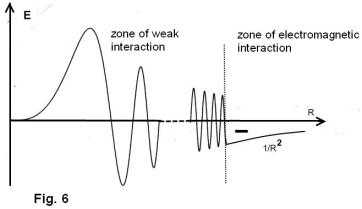
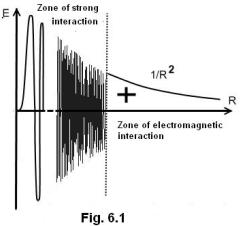
According to the theory of a big explosion in the beginning our Universe had a limited volume, then
it began expanding.
Let us try to model this process on a water model with
consideration of trembling of the whirlpool model.
Let us take a limited vessel (a basin) and make it tremble–vibrate. What do
we see? Because of the limited space the waves reflect off the walls and start harmonizing — it is not white nose with uniform spectrum. When the vessel is bigger, the waves are divided and accumulated in a superconducting
medium. It can be seen well, if you take a glass, shake it and look at the ripple on a sea. The harmonics, which appear in the krypton space, also can influence the stability
of whirlpools, their formation and frequency of fluctuations (beating).
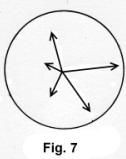
![]()
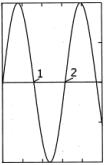
![]()
If a whirlpool has a view like in fig. 8., then by the law of self–inductance division will happen, the whirlpool will create its opposite image,
losing half of its energy (an electron — a positron, a particle — an antiparticle).
We should not forget, that whirlpools can be both with the minus
sign, and with the plus sign (fig. 4.1).
When such a whirlpool antenna emits an electromagnetic wave — a light quantum, it will impart
a rotation momentum to the quantum of light and pack it in the form of a spin
with a changing density of the krypton (fig. 9).
Therefore the light quantum as if screws into space, and its energy will equal the energy of
the electromagnetic wave plus the energy of the krypton bore (the
spin) (fig. 9).
![]()
Therefore quantum antenna, built by an analogous design (fig. 10), causes
interest.
Having sent a laser ray one centimetre in diameter, we shall receive a ray two hundred
meters in diameter (a spot). Quantum antenna are a kind of a rifle, in which, as a result of imparting a rotation
momentum to bullets, dissipation of shot bullets decreases, compared to a
smooth–bore gun.
![]()
In fig. 10 digit 1 is a medium, imitating non–uniform density of a krypton, ![]() is an imitator of a kind of whirlpool, the distribution function (fig. 6, fig. 6.1); V is the angular velocity. When
is an imitator of a kind of whirlpool, the distribution function (fig. 6, fig. 6.1); V is the angular velocity. When ![]() , dissipation
, dissipation ![]() :
:
![]()
Quantum motors, which can be built without rotating parts (using induction) — those are the fields, which rotate, cause some interest too. So, if the mass of a photon is ![]() ,
, ![]() is the intensity of the electric–magnetic field
of the photon, then, in order to create analogous
traction for mass of a body Ì = 1 kg, the following intensity of the field is
necessary:
is the intensity of the electric–magnetic field
of the photon, then, in order to create analogous
traction for mass of a body Ì = 1 kg, the following intensity of the field is
necessary:
![]()
If we create such a bore, we shall be able to create traction, but we need huge intensities of
the electric–magnetic field.
![]()
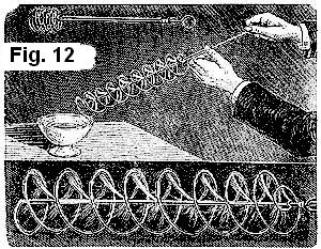
![]()
![]()
But how can we create such fields? From the experiments by Faraday
fig. 11, we know, that if we make a body hollow, an as big charge, as desired, can be
given to it — the Van de
Graaff electric generator.
In order to give the necessary configuration to the field, a hollow
lengthy cylinder will suit the best, fig. 11.1, or a conducting tube, which is bended
easily, in which the charge will be accumulated on the surface too. The configuration of the field, which must be created, resembles a
soap screw (fig. 12). We shall use the same construction. We shall build it in the form of hollow conducting cylinders, charge the outer spiral and the inner axis with opposite charges and impart rotation (fig. 13) (analogue of Archimedean electric–magnetic screw). The received traction force will
be:

where
Ê is the coefficient of
proportionality, ![]() is the rotation frequency, Å(à) is the vector of the intensity of the electric field, L(à) is the length of the spiral,
is the rotation frequency, Å(à) is the vector of the intensity of the electric field, L(à) is the length of the spiral, ![]() is the angle of intersection of the tangent to the spiral with the axis,
R(a) is the distance from the spiral to the axis.
In fig. 13, 1 is a hollow cylinder, which allows the charge to be accumulated on the surface, when it is transmitted to the cylinder, 2 is a thread, 3 is a motor, 4 is a jacket for exclusion of the
effect of repulsion off air (although vacuum is necessary, there are no
possibilities). In fig. 14. 2 is a spring, which marks deviation and force F. The cylindric construction in fig. 13 vibrates at prerotation,
the construction
in fig. 14 —
(the whirligig) is more stable.
is the angle of intersection of the tangent to the spiral with the axis,
R(a) is the distance from the spiral to the axis.
In fig. 13, 1 is a hollow cylinder, which allows the charge to be accumulated on the surface, when it is transmitted to the cylinder, 2 is a thread, 3 is a motor, 4 is a jacket for exclusion of the
effect of repulsion off air (although vacuum is necessary, there are no
possibilities). In fig. 14. 2 is a spring, which marks deviation and force F. The cylindric construction in fig. 13 vibrates at prerotation,
the construction
in fig. 14 —
(the whirligig) is more stable.
Let
us make some conclusions:
1. The the whirlpool–krypton model connects the relativity theory with the quantum theory and examines the experiments from a
different point of view.
2. Any acceleration causes changing of a krypton density ![]() and creates gravitation.
and creates gravitation.
3. The velocity of light light is the function of density of a krypton ![]() .
.
4. The variety of elementary particles corresponds to the variety of whirlpools (depending on the packing).
5. Space and time are
discrete.
6. All constants
change and depend on density, except correlations.
7. Gravitation is changing of the density of space (a
krypton)
8. The whirlpool–krypton model was created as an alternative
to the string theory.
In the simplified variant âîäîâîðîòî – êðèïòîíîâàÿ the model
means, that the space round us (vacuum) is as though water, and a matter and we
consist of small whirlpools at the expense of which rotation the changing
density êðèïòîíà is created, that creates
gravitation and which property depend on a way of their packing.
Part 4
Pyramids. Experiments with Brown movement in a pyramid
Let's spend
experiment. We will observe Brown movement of a particle in a nutria of a
pyramid and out of a pyramid fig. 1
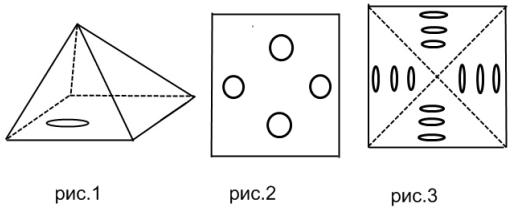
On fig. 1 the pyramid on fig. 2 distribution
of Brown movement out of a pyramid is represented ![]() at Dt=const on fig. 3
distribution of Brown movement in a pyramid at the same of a condition. It is
visible, that distribution from a circle has passed in an ellipse with
preservation of
at Dt=const on fig. 3
distribution of Brown movement in a pyramid at the same of a condition. It is
visible, that distribution from a circle has passed in an ellipse with
preservation of ![]() average value on a circle. At
movement from pyramid edge to the centre average value changes
average value on a circle. At
movement from pyramid edge to the centre average value changes ![]() approximately as:
approximately as:
![]()
![]()
Where ![]() - distance from the pyramid centre. Value
- distance from the pyramid centre. Value ![]() is difficult for defining
because of the big error, most likely the pyramids caused by the small sizes.
As a result a pyramid it is possible to present as system of pipes fig. 4, fig.
5
is difficult for defining
because of the big error, most likely the pyramids caused by the small sizes.
As a result a pyramid it is possible to present as system of pipes fig. 4, fig.
5
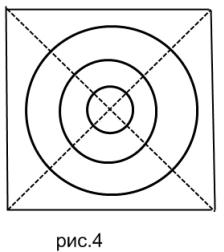
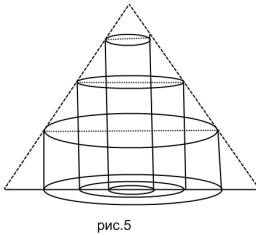
And the pyramid can be considered as a resonant contour
.
These changes are caused, most likely, from for redistributions of is
likelihood predetermined function of movement of speeds of molecules in a
pyramid from a spheroid to ýëëèïñîèäó as is
shown in fig. 6. (It as a sphere which have squeezed on each side one high-speed
co-ordinate has decreased, and two others have increased thus volume and the
area of a sphere passed in ýëëèïñîèä have not
changed – there was a redistribution of speeds on co-ordinates).
![]()
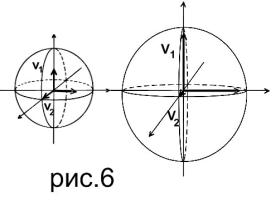
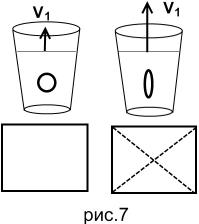
From for this redistribution of speeds vertical speed
on surfaces of a glass with water in a pyramid increases in comparison with a
glass out of a pyramid fig. 7 and it is possible to calculate on how many
evaporation (that is time for which will evaporate all liquid in a glass in a
pyramid and out of a pyramid) will increase. Such redistribution of speeds most
likely is caused by spatial changes and puts questions:
- Whether it is possible to use this asymmetry for
energy reception
- To use as the receiver for fixing
of spatial waves (gravitational)
Ñïèñîê
èñïîëüçóåìîé ëèòåðàòóðû
1. À. Ýéíøòåéí. Òåîðèÿ îòíîñèòåëüíîñòè. 2000 Íàó÷íî-èçäàòåëüñêèé öåíòð. Ðåãóëÿðíàÿ è õàîòè÷åñêàÿ äèíàìèêà
2. Ôåéíìàí Ð., Ëåéòîí Ð., Ñýíäñ Ì. - Ôåéíìàíîâñêèå ëåêöèè ïî ôèçèêå.
3. Ïðèíöèï îòíîñèòåëüíîñòè” Ëîðåíö, Ïóàíêàðå, Ýéíøòåéí è Ìèíêîâñêèé; ÎÍÒÈ ; 1935 ã., ñòð. 134,51,192
4. Ïîëíîå ñîáðàíèå òðóäîâ, Ë. È. Ìàíäåëüøòàì; Òîì 5, ñòð. 172
5. Âåñòíèê íàöèîíàëüíîãî òåõíè÷åñêîãî óíèâåðñèòåòà "ÕÏÈ" ¹8 2009ã Òåìàòè÷åñêèé âûïóñê «Íîâûå ðåøåíèÿ â ñîâðåìåííûõ òåõíîëîãèÿõ» ñòð.81 ;Ñ.Í.ßëîâåíêî ׸ðíûé ïðåäåë. Õàðüêîâ., 2009 ã.
6. Âåñòíèê íàöèîíàëüíîãî òåõíè÷åñêîãî óíèâåðñèòåòà "ÕÏÈ" ¹43 2008ã Òåìàòè÷åñêèé âûïóñê «Íîâûå ðåøåíèÿ â ñîâðåìåííûõ òåõíîëîãèÿõ» ñòð.144 ;Ñ.Í.ßëîâåíêî ׸ðíûé ïðåäåë ÷àñòü 1 Õàðüêîâ., 2008 ã.
7. «×¸ðíûé ïðåäåë.
Òåîðèÿ îòíîñèòåëüíîñòè: íîâûé âçãëÿä» ÒÎÂ èçäàòåëüñòâî «Ôîðò» 2009ã. ISBN 978-966-8599-51-4
530.1
Ô 50
ÓÄÊ 530.18 (ÓÄÊ 530.10(075.4)) ßëîâåíêî Ñ.Ì. Òåîð³ÿ â³äíîñíîñò³ - íîâèé ïîãëÿä.
Ðîçãëÿíóòî òåîð³þ â³äíîñíîñò³ ç òî÷êè çîðó êîëîâîðîòíî¿ òà äèñêðåòíî¿
(êðèïòîíîâî¿) òåîð³¿.
Ý-534
ISBN 5-93972-002-1
530.1
Ô 50
ÓÄÊ 530.18 (ÓÄÊ
530.10(075.4)) ßëîâåíêî Ñ.Í. . Òåîðèÿ îòíîñèòåëüíîñòè: Íîâûé âçãëÿä.
Ðàññìîòðåíà òåîðèÿ
îòíîñèòåëüíîñòè ñ òî÷êè çðåíèÿ âîäîâîðîòíîé è äèñêðåòíîé (êðèïòîíîâîé) òåîðèè.
530.1
Ô 50
ÓÄÊ 530.18 (ÓÄÊ 530.10(075.4)) YAlovenko S.N
. Theory
to relativity - a new glance.
In article is considered theory to
relativity with standpoint turn water
and
discrete (the krypton) to theories.